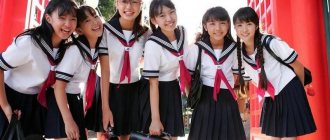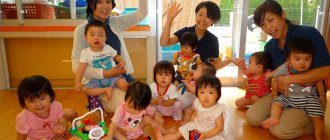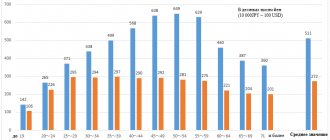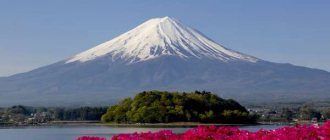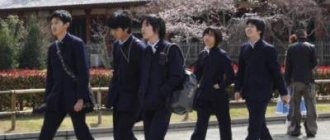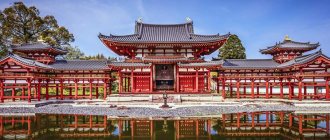April 12, 2016
Averyanova Sveta
We all know that the Land of the Rising Sun is a special world. There is not a single people on the planet whose culture would be identical to the Japanese.
Worldview, social relations, traditions and much more attract attention to this amazing country. Europeans have long been trying to comprehend its mysteries. And one of them is raising children in Japan.
In fact, almost everyone has at least heard about the interesting approach of the Japanese to this issue. It is so different from the principles we are accustomed to that it causes bewilderment and rejection. However, due to the enormous interest in Japanese culture and the desire of many to bring pieces of it into their lives, it is worth talking about this topic in more detail.
Let's try to understand what the system of raising children is. What is its meaning and is it possible to adopt approaches that are alien to us?
Philosophy of "Ikuji"
The main educational principle in Japan is called “Ikuji”. It divides the child's life into several periods, during which the attitude towards him on the part of parents and others is very different. So baby:
- Up to 5 years - god
From birth, the baby is treated like a god, completely surrounded with care, love, and indulged in all his whims. If he is naughty, it is unlikely that he will be severely punished or scolded.
Even newborns rarely cry, because the mother knows in advance what the child wants and rushes to calm him down. At first glance, this approach seems permissive, but in the Japanese understanding, they do not spoil the kids, but let them know that they are good and loved no matter what.
- From 6 to 15 years - slave
From the age of six, children go to school, where they are taught to live by strict rules and become part of a team. Boundless parental love does not go away, it just manifests itself differently.
Within the walls of school and at home, the concepts of what is good and bad are instilled in him, and it is explained how to behave in society in different situations. At the same time, the needs of the team are the priority, and personal interests become secondary. In this way, the student is given the opportunity to take a place in the team, to become a “team player” - and this, as we know, is a generally accepted model of social relations in Japan.
In Japanese kindergartens and primary schools, they do not primarily teach, but educate. There are no best or worst here - everyone is equal. And the worst thing that can happen to a child is to be removed from the team.
- From 15 years old - adult
The teenager is already becoming a full-fledged member of the team, his worldview has already been formed, but it will be difficult to re-educate him. 15-year-olds are already treated like adults, given the opportunity to make their own decisions, choose a profession, and therefore their future destiny.
The Ikuji philosophy may seem paradoxical: a child who was allowed everything for the first five years of his life grows up to be a responsible, educated member of society, working for the benefit of the group and the country as a whole, without a shadow of selfishness. But such a system works perfectly in the Land of the Rising Sun due to the social system that has developed there.
The child is god
Copyright Shutterstock
Until the age of five, according to the principles of ikuji, a child is a celestial being. Nothing is forbidden to him, he is not shouted at, he is not punished. For him there are no words “impossible”, “bad”, “dangerous”. The baby is free in his cognitive activities.
From the point of view of European and American parents, this is pampering, indulgence in whims, and a complete lack of control. In fact, parental authority in Japan is much stronger than in the West. And all because it is based on personal example and appeal to feelings.
In 1994, a study was conducted Nihonjin no shitsuke to kyōiku: hattatsu no Nichi-Bei hikaku ni motosuite differences in approaches to teaching and education in Japan and in America. The scientist Azuma Hiroshi asked representatives of both cultures to assemble a pyramid construction set with their child. As a result of observation, it was revealed that the Japanese women first showed how to build a structure, and then allowed the child to repeat it. If he was wrong, the woman started all over again. The Americans took a different path. Before starting to build, they explained the algorithm of actions to the child in detail and only then, together with him (!), they built.
Based on the observed differences in pedagogical methods, Azuma defined the “instructive” type of parenting. The Japanese teach their children not with words, but with their own actions.
At the same time, from a very early age, a child is taught to be attentive to feelings - his own, those of the people around him, and even objects. The little mischief maker is not driven away from the hot cup, but if he gets burned, amae asks him for forgiveness. Not forgetting to mention the pain the child’s reckless act caused her.
Another example: a spoiled child breaks his favorite car. What will an American or a European do in this case? Most likely, she will take the toy away and lecture her about how hard she worked to buy it. The Japanese woman will not do anything. He will only say: “You are hurting her.”
Thus, until the age of five, children in Japan can formally do anything. Thus, the image of “I am good” is formed in their minds, which later turns into “I am well-mannered and love my parents.”
Family traditions
If we talk about how many children there are in a typical Japanese family, the average number is 2: the average social unit consists of a mother, father and two children. Since ancient times, each family member has had its own name:
- shujin - master;
- kanai – housewife, literal translation – “inside the home.”
The relationship between husband and wife remains traditional: the husband earns money, spends a lot of time at work, the wife takes care of the family hearth. And although modern women usually work, household chores, and especially raising the younger generation, are still their responsibility.
There is also some subordination between children by gender and age. When saying “brother” or “sister”, the Japanese always specify whether they are older or younger. The main child, to whom everyone listens, is the first son in the family, because, according to tradition, he was considered the heir to the property of the entire family.
A close connection can be traced between grandparents. Recently, a woman does not stay on maternity leave until the child is 3 years old. Therefore, the role of nannies is performed by the older generation, who dote on their grandchildren.
Progress and personality development
Japan is a country with rich traditions, in which the ritual side plays a very important role. On the other hand, everyone knows about the highest level of technology for which Japanese industry is famous. This progress is partly due to the Japanese focus on collective values and interests. The respectful attitude toward work cultivated from childhood, the principle of “don’t stand out,” molds the Japanese into hardworking, surprisingly polite and obedient workers. The Japanese are very enthusiastic about the idea of early childhood development. Personality education in Japan is a unique fusion of the traditional basis of education and the desire to develop creativity, character and thinking in a child as early as possible. Masaru Ibuka, a Japanese, the founder of the organization “Training of Talents”, the author of the sensational book “After Three It’s Too Late”, believes that the main education of the individual occurs before the age of 3. Not everyone knows that he is the creator. In Japan, early development methods are very popular, and this is bearing fruit. The combination of ancient traditions and modern methods of personality education is the recipe for success in Japan.
Boys and girls
The birth of a child is the main event in the life of a family. And although gender prejudices are a thing of the past, the birth of a boy becomes a doubly festive occasion, because he is the successor of the family.
Boys and girls study together, but family education depends on gender. Boys are treated more strictly; they are expected to be firm, able to withstand difficulties and solve problems. They are sent to the sections of martial arts, sports, programming, and mathematics.
When raising girls from an early age, much attention is paid to teaching housekeeping. They are taught to cook, wash, clean, iron, and create comfort in the home. As for additional activities, they are given concessions and they prefer to choose painting, music, and dance clubs for them.
Early child development
Japanese experts in the field of pedagogy first spoke about the need for early development of children back in the 1950s. Previously, this sounded like something unusual, but now many people adhere to this point of view. In the first years of their lives, children are able to learn much faster than older children.
Therefore, the goal of parents should be to create all conditions for the highest quality and comprehensive development of the child. They should arouse interest in children, stimulate the desire to learn something, develop creativity and form character. The baby must be healthy, smart and kind.
Children and parents
The main person in the life of a small child is the mother. In Japanese it is called “amae”, which means “to take care of”, “to pamper”, “to connect with the heart”. It is expressed in a feeling of mutual affection, sometimes even dependence.
In the maternity hospital, a piece of the umbilical cord is preserved, which is then dried and placed in a special wooden box, lavishly decorated with decor and engraving. It becomes a symbol of the connection between mother and child.
Japanese mothers walk with their newborns everywhere, tying them to their bodies with the help of special bandages and carriers. But even when the little one begins to walk on his own, his mother does not leave him a single step, always tries to entertain him, comes up with educational games, and shows everything by example.
The child, in turn, copies the behavior of family members, so all adults and older children try to be a role model.
In the popular book “Japan. How to Understand It" by Ikeno Osamu talks about an experiment with a toy pyramid, where mothers were given the opportunity to teach their children to play with it. If European mothers explained in words how to build a pyramid, then Japanese mothers first built it themselves so that the baby could see how it was done, and the second time they provided the child with a toy, helping with difficulties.
The role of “amae” can be played not only by the mother. In Japan, ties between close relatives are very strong, so the child becomes attached to his father, brothers, sisters, and grandparents.
Only parents shape the child's personality
Those emotions, impressions, sounds, images and experiences that a child experienced in infancy will forever take root in his subconscious and play a key role in the formation of his personality.
We are accustomed to thinking that a baby born as a human automatically acquires human manners. But the processes of a child’s adaptation to the world are truly amazing. Suffice it to recall the story of the “wolf girls”, the twins Amala and Kamala. In the 1920s in India, a missionary and his wife discovered two girls who had been raised by a wolf pack. Despite all the couple’s attempts to teach the girls “human” behavior, they continued to exhibit wolfish habits. The foundation that was laid for the little ones from the first days remained with them for the rest of their lives. This confirms that it is the environment and atmosphere in which the baby grows that determines his future perception of the world.
A similar example is given by Ibuka Masaru - this is the story of a Japanese girl who spent the first year of her life with her grandparents in the Tohoku province. A year later, the parents took the baby to Tokyo. At that moment the girl was not yet speaking. But what a surprise the parents were when, having spoken, their little daughter used words in the Tahoku dialect. Although none of her parents in Tokyo spoke this dialect to her.
Even when the little girl went to school, she could not switch to the generally accepted Japanese language and continued to speak in a dialect. This case clearly demonstrates that a child learns to speak long before he utters his first word. And it depends only on the parents what word it will be. Those emotions, impressions, sounds, images and experiences that a child experienced in infancy will forever take root in his subconscious and play a key role in the formation of his personality.
The Japanese are sure: geniuses are not born, they are made. Mozart, who masterfully played the piano at the age of three, or John Stuart Mill, who read classical literature in Latin at the same age, were not special at birth. But the information given at the right moment and the skill learned in childhood remained with these guys forever and made them outstanding people of their time.
Every child is talented. But it depends only on the efforts of the parents whether the child will be able to use his talents in the future.
Principles of Japanese education
Japanese education is different from Western education. Briefly speaking about its main principles, we can name:
- a call to respect the interests of others;
- calm;
- personal example;
- patience;
- endless Love;
- development of self-control in the pupil;
- understanding children's sensitivity;
- the desire to make the child a useful member of society;
- the emphasis is not on individuality, but on participation in the group.
In a Japanese team, everyone is equal. The desire for equalization also has the other side of the coin - a child who thinks differently from the crowd, is somehow different from others, is subject to bullying, bullying, and ridicule. This phenomenon even has a special name - “ijime”.
Trip to Japan: memories and recipes
When our son was three years old, he saw on TV the famous Japanese “Shinkansen”, which is sometimes called a “bullet train” for its speed, and all day long he talked only about it.
For my part, I have long wanted to show him the places where I spent my childhood. About a year later, the two of us boarded a plane from New York to Tokyo. We spent the whole summer in Japan living the life of ordinary Japanese. All this time I watched and diligently memorized what and how local families cooked, so that upon returning to America I could use the acquired knowledge and skills in practice. I enjoyed helping my mother prepare traditional food that Japanese people eat in everyday life.
After several days in Tokyo, we boarded that same “bullet train” and went, or rather, rushed to the small mountain village of Kozaka, where our family farm is located. Beautiful Japanese landscapes flashed past the window, the silhouette of Fuji rose in the distance, and I remembered my childhood spent on this farm. Pictures of a traditional autumn fair came to mind, to which local farmers brought all kinds of vegetables and fruits. It was as if in reality I felt the half-forgotten taste of ripe tangerines - as a girl I picked them straight from the tree...
I also remembered that none of my friends at that time had ever been sick or complained about their health. Back then I took it for granted. I didn’t yet understand that we were simply lucky to be born and grow up in a country whose people, over many centuries, had created a special everyday culture that allowed a person to enjoy a long life, not overshadowed by illness.
Kindergarten
Children are sent to kindergarten from about 3 years old. However, in exceptional cases, for example when both parents work full time, a three-month-old child may be sent to a nursery - hoikuen. They are open from 8 am to 6 pm.
Another type of garden, both private and public, is called etien. The guys are here for the first half of the day - from morning until afternoon.
Elite kindergartens are considered the biggest dream for Japanese parents. They are supported by a specific university, so by enrolling here, the child will go to school at the university after graduation, and then automatically enter the university.
It is very difficult to get into an elite kindergarten: there is a strict selection process, and training costs incredible amounts of money. How many children will be in the group depends on the particular kindergarten, but usually they do not exceed eight people. The teacher here is more likely not a teacher, but a coordinator: he helps the children organize themselves and direct the game in the right direction.
Interestingly, the mentors and the composition of the groups themselves change periodically, so that each child gets used to the constantly changing conditions and finds a common language with everyone. If conflicts arise, students usually learn to resolve them themselves, and then the mentor analyzes them and tells them how to behave correctly. Any dispute should end in a compromise solution that will not offend anyone.
The main rule is to avoid competition. To unite the team, children are offered appropriate activities: choral singing, where there is no soloist, team sports games, in which victory is shared by the whole team.
Children also engage in creative activities that develop fine motor skills: origami, painting, weaving, appliqué. In the future, this will help display hieroglyphs correctly.
The purpose of preschool institutions is not just education, but the upbringing and comprehensive development of future citizens. It instills in young minds an understanding of shared responsibility and team consciousness.
Why do the Japanese almost never get sick?
Let’s say right away: modern science does not give us an exact answer to this question. For a long time there was an opinion that it was all about genes, but today scientists have proven that this is not so.
Here's what Dr. Robert Vogel, a professor at the University of Maryland School of Medicine, says: “Genes don't seem to have anything to do with it. We studied statistics on cardiovascular diseases among Japanese men living in Japan, as well as in Honolulu and San Francisco, America. It turned out that life expectancy and the incidence of heart attacks and strokes among ethnic Japanese living in the United States coincide with similar indicators among representatives of other ethnic groups inhabiting the Hawaiian Islands and the state of California.”
French doctors came to the same conclusions. The head of a research group at the Lyon State Research Center that studied the connection between the Mediterranean diet and the prevention of heart disease, Michel de Lorgeril, is convinced: “Genetic characteristics do not serve as insurance against disease for the Japanese.”
Perhaps one of the reasons that the Japanese live longer than other peoples is the presence of a developed healthcare system that guarantees every citizen high-quality free medical care. As part of the fight against the threat of cardiovascular diseases in the country, several national campaigns have been carried out to persuade the population to reduce their salt intake.
Great attention is paid to disease prevention: government-funded medical examinations are regularly conducted in schools and other institutions. In addition, one should not discount the traditional Japanese cleanliness, thanks to which Japan has been able to significantly reduce the rate of infant mortality and childhood infectious diseases.
The Japanese lifestyle also plays a role. Japanese society is incredibly close-knit. Representatives of different social groups traditionally maintain the closest ties with each other, and the concept of ikigai, which means “the purpose of life,” is firmly rooted in the collective consciousness. All kinds of competitions for erudition and ingenuity are extremely popular, which helps the Japanese relieve stress successfully and without any medications.
University of Tokyo professor Kenji Shibuya, together with colleagues from the Ministry of Health, identify three factors that, in their opinion, explain why the Japanese live longer than all other peoples on our planet.
“Firstly, the Japanese pay increased attention to personal hygiene. This habit may be related to the climate - humid and hot in some areas of the country, and perhaps to the traditional Japanese religion of Shinto, which requires a person to undergo a procedure of cleansing the body and mind before meeting other people. Secondly, the Japanese are conscious about their health and are not lazy to undergo preventive medical examinations in due time. This allows for early diagnosis of diseases and increases the chances of their successful treatment. Thirdly, Japanese cuisine is characterized by maximum balance of nutrients. The higher the country's economic growth, the better the Japanese population eats."
School
School for a child is the most important stage of life. Coming here, he turns from a “god” into a “servant,” and when he finishes middle school and moves on to high school, he becomes an adult.
The school is divided into three stages:
- primary – from 6 to 12 years;
- average – from 12 to 15;
- senior – from 15 to 18.
The school bench is a place where rules, restrictions, and own laws reign. But they also serve the main purpose - socialization in the team.
The teachers at school are mostly men.
The Japanese school curriculum includes many subjects similar to those in other countries: native language, foreign language (most often English), mathematics, science, painting, physical education, history, music, labor, social studies. The older the class, the more difficult it becomes.
To emphasize the equality of all students, it is customary to wear the same clothes - school uniforms.
Japanese school uniform
A typical day for a Japanese child goes like this:
- 5-6 am – wake up, hygiene procedures, breakfast.
- 7-8 am – repetition of lessons, self-education.
- 8-15 hours – school lessons. Each lesson lasts 45-50 minutes, with breaks including outdoor games or lunch. Classes are usually large, up to 40 students.
- After classes - a visit to the so-called juku, which can be called one of the features of Japanese education - additional classes, clubs, sections, tutors.
- At 7-8 pm, schoolchildren return home, where homework still awaits them.
The everyday life of schoolchildren is very stressful, they devote almost the whole day to studying, self-education, reading, and there is practically no free time left. In high school, the workload increases because exams are approaching, on which admission to higher educational institutions depends, which determine the career, and therefore the whole life of a Japanese person.
Japanese cuisine in other countries - it's possible
Since I became a mother seven years ago, I have tried to feed my son healthy, nutritious, and delicious food whenever possible.
Sometimes it worked, like the day I gave him avocado puree as his first food, or later when I steamed sweet potatoes, which he loves, and stewed beets, or when my American husband spoiled us with breakfast in the morning , prepared according to traditional Japanese recipes (to be fair, I admit: those that require no more than five minutes). On other days we ate what children usually like - pizza, chips, french fries, muffins. But still, Japanese dishes appeared on our menu from time to time.
What's good about Japanese cuisine? First of all, its simplicity. The ingredients for the Japanese menu are usually the simplest products that are easy to buy anywhere - in a supermarket, small shop or market. Probably, chefs from Japanese restaurants have their secrets, but I don’t consider them that important. In my opinion, any housewife can handle most Japanese dishes. And what’s most interesting: modern recommendations from nutritionists almost completely coincide with the rules of nutrition culture adopted in Japan.
Rest
Rest for children - Saturday afternoon and all Sunday. On weekends, the family tries to spend time together, even dads who work hard all week join the family. Usually the family goes to parks, for a picnic, for a regular walk, to special entertainment centers or to visit older relatives.
In Japan, family values are paramount. Even teenagers spend their weekends more often not with friends, but with family.
Preschool education
Children attend kindergartens in Japan at the request of their parents. Modern Japanese mothers increasingly refuse to interrupt their careers for 5 years and send their children to kindergarten.
Preschool education in Japan pays little attention to school subjects.
The main thing is to cultivate good manners, respect for elders and other things that are important to the Japanese. They play with the kids, go for walks, play sports and play music.
Holidays
In Japan, there are several celebrations that are dedicated specifically to children. We want to tell you what holidays these are.
- Girls' Day
Celebrated in early March. It can be called an analogue of March 8, but its main difference is that not all women are congratulated, but only little princesses.
On this day, the girl's collection of dolls is displayed in a prominent place in the house. It is constantly replenished, and by the time of marriage a girl may have about two dozen beautiful porcelain dolls. It is believed that they act as an example of aesthetics and teach girls to see and create beauty.
- Boys' Day
Celebrated on May 5th. It is celebrated in a similar way, but with the only difference that instead of dolls, soldiers, weapons, and uniforms are displayed. Pictures of carp of different colors are also hung near houses as a symbol of perseverance and the ability to swim against the current.
- City-go-san
In addition to the usual birthdays, there is a holiday called “shichi-go-san”, which translates as “3-5-7”. Its meaning is that on this day everyone who turns three, five and seven years old is congratulated. The fact is that the most favorable numbers in Japanese numerology are odd, and these dates are considered big steps on the road to growing up.
Why Japanese children are lucky
Japanese children not only live in a developed country with an effective healthcare system, but also enjoy all the benefits of traditional behavior patterns, including food behavior, aimed at maintaining a healthy lifestyle.
When our son was three months old, my parents flew from Tokyo to New York to see him. On the first evening, my mother Chizuko prepared home-made Japanese food from American ingredients bought at a nearby supermarket; My father Shigeo was rocking his grandson in his arms at that time. Our apartment was gradually filled with delicious aromas, and we listened to the wonderful sounds of an ancient Japanese lullaby, which grandparents sang to the baby in two voices.
Like all mothers in the world, Japanese women show love for their children, including through preparing delicious food. Natural wisdom, supported by strong historical traditions, helps them raise the healthiest children on Earth.
Education from 6 to 15
An ordinary Japanese family devotes a lot of time to cultivating moral values in their child. Moreover, training and mental development always fade into the background. First of all, the child must be obedient and understanding. The child must observe traditions, take part in all family holidays, communicate politely with adults and serve the interests of society.
At the age of 6, a child begins to go to school. From now on, parents relieve themselves of responsibility for education and shift it onto the shoulders of teachers. Nevertheless, mothers still continue to supervise the child, accompanying and picking him up from school and closely monitoring his progress. Education in the lower grades is free, but in the upper grades it is paid. Therefore, a feature of raising children in Japan after the age of 5 is the instillation of thrifty spending skills. The Japanese do not attach much importance to money; they instill in children a love of life, and not of banknotes. But training pays many dividends. Therefore, wealthy parents want their child to graduate from a fee-paying school and enter university. Knowledge is rewarded by Japanese society, so a person who has received a higher education is considered privileged.
An interesting feature of Japanese schools is that a student’s classmates and teachers change every year. This system was invented so that teachers would not play favorites, and the children could learn to socialize in a new team.
The results of one final exam make all the difference
0
At the end of high school, schoolchildren take one test that decides whether they will enter a university or not. A graduate can choose only one institution, and what it will be will determine the size of the future salary and standard of living in general. At the same time, the competition is very high: 76% of graduates continue their studies after school. This is why the expression “exam hell” is popular in Japan.
Respect for adults
The rules for raising children in Japan are regulated by traditions and customs. A large number of children is difficult to support if they do not obey on demand. For this reason, traditional obedience and respect for adults are instilled in children from infancy. Moreover, a strict hierarchy between ages is always observed. Children absorb this knowledge from childhood, as it is embedded in the family. A child does not have just sisters or brothers. He always has an older sister or a younger brother. Such postscripts are voiced every time a person is addressed, and this helps the baby realize his place in this hierarchy. Mothers teach their children to treat family members with respect first. A child must respect his mother, father, and grandparents. If a child has learned the essence of a respectful attitude, then they begin to take him out into the world. If the baby does not understand who and how to contact him, then they try to keep him in the house and not even show him to the neighbors. Moreover, the neighbors will not condemn such a manifestation of the child’s willfulness, but they will look askance at the parents.
A minimum of prohibitions and faith in innate goodness: how children are raised in Japan
They say that the most harmful babies in the world grow up in Japan. But by the end of 1st grade they become the most disciplined students in the world. How does this transformation happen and what do the Japanese know about parenting that we don’t know,” says Svetlana Beletskaya, who spent almost a year in Japan.
Useful Mela newsletter twice a week: Tuesday and Friday
SUBSCRIBE
XVI century. Europe, or more precisely, France. The unpredictable Michel Montaigne gave a paradoxical formulation to the teacher: “A good teacher is one who knows how to very nicely close his eyes to individual children’s sins.” Thousands of kilometers from France, a small people from the Japanese islands showed the whole world how it is possible in practice to “very nicely turn a blind eye to individual children’s sins.” I studied this version of “closed eyes” for about a year (I conducted research at the oldest women’s university in Japan, Ochanomizu University) and this is what I found out.
Adults in Japan believe that a child is born with a strong calling to love and be loved.
According to the views of the ancient Japanese, up to the age of seven, children are pure and blameless, they are closest to God and do not know sin. They are kind and good, they simply cannot be anything else. This is exactly what the basic idea of the entire educational philosophy of the Japanese approach to children sounds like. Thanks to her, the moaning of our mothers “he is doing it to spite me” is not known to the Japanese. At the mass level, the Japanese believed and still believe in the “goodness” of every baby.
Believing in the innate goodness of a child, the Japanese strive for harmony rather than obedience in education.
And that's what they're great at. Westerners have always been puzzled by the Japanese attitude towards children. The first exclamations of surprise were heard in the 17th century from the lips of Francoys Caron (1645), who wrote:
“They raise their children carefully and gently. They believe that children are not old enough to understand, so children just need to be patiently guided.”
All subsequent generations of observers continue to be amazed. Our contemporary, David McConnell, at the end of the twentieth century, echoes his predecessors: “All those rules that we were accustomed to during our childhood - do not eat in the room, do not jump on the sofa, do not have a snack before meals, lie down sleep at a certain time - all seem too strict in the context of Japanese standards, as if we are trying to make adults out of our children before they are ready.
When you read all these statements, against your will there is a desire to figure out whether this is so, whether there is an exaggeration here. Based on my research, I can make clarifications: attitudes towards discipline in Japanese history changed and there were periods, for example, the Meiji era (1868–1926), when the rules of control in Japanese families were quite strict. The Japanese have always had rules and restrictions for children, they just have different accents that are not quite familiar to Westerners.
Philosophy of Japanese education
1. A child is a priori incapable of bad deeds.
The Japanese believe that a child can behave badly due to a lack of information and ignorance. But only! I witnessed the following scene: a teacher took a stone from a four-year-old child, which he was about to throw at a friend. The adult showed and explained that the stone could hit someone. After that, he calmly returned the weighty cobblestone into the naughty man’s palm.
2. Young children are limited in their ability to follow the instructions of others.
In other words, until the age of six or seven, a child simply cannot perceive your rules, prohibitions, he cannot understand the connection between his offense and your punishment.
3. Restrictions in childhood lead to the child becoming an “unhappy adult.”
Therefore, Japanese children not only move freely throughout the kindergarten (both indoors and on the adjacent playground), they literally “fly” around the premises. The unimaginable noise, a constant attribute of any children's institution, is simply stunning. It’s hard for you and me to even imagine. It is interesting that educators not only do not calm down their students, but, on the contrary, encourage them to be “energetic.” For example, at one of the first-grade meetings, at which the results of the day were summed up, I heard a dialogue that was very unusual for our mentality. Toban (leader of the day) asked the question: “raise of hands who today achieved our goal of “play outside with energy.” Everyone raised their hands. The next day, one of the students signaled his failure to achieve this goal. In response, he heard: “Try harder tomorrow!” Can you imagine such a situation here? I'm not, unfortunately.
This tactic is explained by the philosophical position of Japanese educators, who view noise and hyperactivity as a natural manifestation of children's nature. Many teachers at Ochanomizu University Elementary School told me that “it is important for children to be able to behave in accordance with their age, to feel like children.” Japanese mothers follow the same philosophy: they will never scold their baby for running around and making noise, since “that’s what children are for, to play and move.”
How the Japanese discipline their children
Japanese mothers are much less likely than Western mothers to resort not only to threats and punishment, but also to “softer” verbalization - to persuasion and persuasion.
Japanese women more often turn to emotions, they focus on questions and “reasoning out loud”, they focus the child’s attention on the consequences of his action (for example, they say: “You wouldn’t want to be hit with a cube like you did,” “Vegetables help you grow up strong and healthy”, “The store owner works really hard to keep those shelves neat”).
As for physical punishment, in Japan the “mother-child” relationship changes towards “tightening” when the child reaches five or six years old
It is believed that at this age a child is already able to understand family rules and standards, he can act more responsibly. Most often, physical punishment is used in situations where children show disrespect for elders (for example, cases of lying).
It cannot be said that Japanese children are completely ignorant of physical punishment. Spanking is present in the life of the little islander, although they encounter it much less often than their parents did.
The Japanese practice indirect influence on the child (not a direct instruction “do this or not that way,” but influence through the situation). They focus their attention on emotional closeness with the baby; physical punishment is not as common among them as in Slavic countries.
It is impossible not to note the specifics of the Japanese situation: the parent-child relationship very much depends on the age of the child, the educational philosophy for teenagers is completely different than for children of primary school age. Despite this, Japanese authors like to compare their education system with the work of a skilled gardener, who understands that a child, like a plant, has natural inclinations to grow and is very independent in this process. They compare the Western education system to animal education because of the elements of training.
What are the Japanese especially good at? They know how to feel the world of childhood. They know how to “not notice” those child’s actions that are considered a natural manifestation of childhood.
At the same time, their education system is far from connivance and permissiveness. I agree that the Japanese Baby Boss has more freedom than our children. At the same time, restrictions and rules are also present in the life of a child. They gradually become part of the child’s “diet”, as a result of which the child learns to take responsibility for his actions. This is the strength of the Japanese approach.
Kumon Technique
This system was developed back in 1954, and is still being improved.
Today it is used in about 50 countries around the world. In our country, the first manuals were released in 2013.
History of creation
The system got its name from the name of its author, mathematics teacher Toru Kumon. He developed it for his young son, who was struggling with math. By training for 20-30 minutes daily, a lagging student overtook the excellent students in a few months.
Parents of classmates asked to tutor their children. The first training center opened in 1956, and in 1958 Kumon founded the Institute for the Study of Teaching. Today, more than 20 thousand centers are open in the world, but the technique can be successfully used at home.
Features of the technique
The exercises developed by Kumon are based on training those brain centers that are responsible for mathematical abilities. Classes should be daily and short-term – 20-30 minutes. The tasks are repeated until complete mastery, gradually becoming more difficult.
Today, using a similar principle, tasks have been developed for teaching not only mathematics, but also reading, writing, and languages, for children from preschool to high school age.
All exercises are grouped in special notebooks, which are used for training. They are convenient to take with you on visits or trips.
Kumon Workbooks
These are bright, colorful teaching aids that are produced in several age series. They are designed for different ages and development of different skills.
Their structure:
- Cover indicating the name, age of the child, and a brief description of the skills being developed.
- Preface for parents with a brief description of the manual.
- Numbered exercises with a title, a task for the child and instructions for parents.
- Award certificate for completing the exercise book.
On average, a notebook is designed for several weeks of daily lessons with gradual complication. The topics are varied, for example:
- "Let's draw";
- "Simple labyrinths";
- "Educational stickers";
- “Learning to cut”;
- "Games with numbers."
You can buy high-quality notebooks from the Mann, Ivanov and Ferber publishing house, or you can download and print them for free. But the second option is not suitable for all types of tasks.
Principles of the technique
The founder of the methodology formulated the basic principles of training as follows:
- The child should not get tired. Class time is selected so as not to overload the child. For a preschooler, the first lessons can last 10 minutes. Let him complete only 1-2 tasks, this is already the result.
- The child should not be bored. All tasks for kids are playful. You need to color a picture, connect the dots with a line, go through a maze, cut, glue - the activity becomes a fun game.
- Step by step complication. The simplest tasks are given first, and they move on to the next, more complex stage only after the previous one has been fully mastered. For example, first we learn to draw simple lines, then the elements of letters, and only then the letters themselves.
- Praise for every achievement, no matter how small. Encouraging children, traditional for Japanese education, is one of the main principles of the Kumon method. Celebrate all successes, this will inspire your child to continue to strive. It is for this purpose that a special award certificate is inserted at the end of each notebook.
- Encourage independence. Even if a child glues it crookedly or cuts it askew, do not interfere until he asks for help. If he made a mistake, do not rush to correct it. Let him finish the task, and then ask him to first find the mistake and then correct it. Parental assistance should be minimal.
First manners - then knowledge
0
Japanese schoolchildren do not take exams until the 4th grade (when they are 10 years old), only writing short independent ones. It is believed that in the first three years of study, academic knowledge is not the most important thing. The emphasis is on education, children are taught respect for other people and animals, generosity, empathy, the search for truth, self-control and respect for nature.
Perception of the world
Unlike European residents, the Japanese have different values. People don't chase fame or career, they try to be closer to nature. The main task of Japanese education is to teach the child to enjoy the beauty of this world. People can spend hours admiring the beauty of the flower or spend the whole day in the garden with cherry blossoms. Nature has been a source of inspiration for the Japanese since ancient times. Parents teach their children to worship her.
Children and their parents go out into nature every week. People admire the beauty of the surroundings, have lunch and spend time away from civilization and the Internet. It is enough to remember the structure of Japanese gardens, and everything about the Land of the Rising Sun will become clear to a person. The stones in the gardens are not arranged according to some clever system, they lie where the artist put them, because it seemed to him that here the stone would look most harmonious. People do not try to take advantage of everything that surrounds them. They learn to experience beauty through contemplation. This skill helps children, as well as adults, relieve mental stress and clear their minds. It is in moments of admiring beauty that a person can be alone with himself, and not under the eternal gaze of others.

